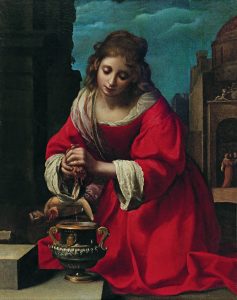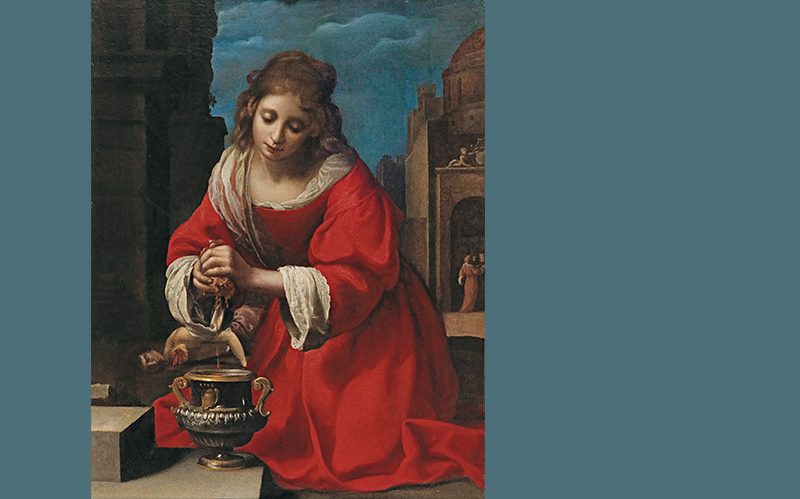
Saint Praxedis: the epitome of focused devotion
A composition that inspired no less a figure than starpainter Vermeer. Family-owned and inaccessible to the public for centuries, it is now up for auction to the public in Dorotheum’s October 2017 old master paintings auction.
The composition of the present painting by Felice Ficherelli (1603–1660) was first described by Filippo Baldinucci in 1681. The work was in the same family collection for centuries and is now offered for sale at auction for the first time in its documented history. It has not been accessible to scholars in the past.
This painting of “Saint Praxedis” appears to be the first version of the composition, which is known primarily in two further variants: another autographed version by Felice Ficherelli, formerly held by the Collection Carlo del Bravo in Florence, is now in a private collection in Ferrara; the second one is a celebrated copy attributed to Vermeer and recently sold at Christie’s, London, for 7.9 million euros.
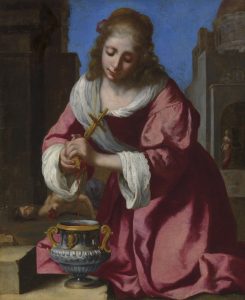
A model for Vermeer
As a matter of fact, the Vermeer version of this painting of Saint Praxedis was initially also attributed to Ficherelli when it was lent to the Metropolitan Museum of Art in New York for an exhibition of Florentine Baroque painting in 1969. There, a Vermeer signature was first noted by the conservation department, leading to the consideration that Vermeer had painted this copy after Ficherelli. According to the art historian Arthur Wheelock, the Vermeer version of St. Praxedis is his earliest dated work, the exploratory painting of a young artist who had recently converted to Catholicism and with a proven interest in contemporary Italian art. The present composition must have left a strong impression on Vermeer not only in terms of artistry, but also on account of its highly unusual devotional character. Given that Vermeer would have had access to Italian paintings, even if he did not visit Italy in person, we must still ask why he would have decided to copy a Ficherelli painting. It might, of course, have been a commission. Perhaps the subject had a special appeal to him.
Praxedis as a role model
Praxedis was a Roman saint who enjoyed popularity among the Jesuits in the 17th-century as they sought to emphasize the early traditions of the Catholic Church. Vermeer’s interest in Jesuit ideas at the time must have been acute. Although he had been baptized in the Reformed Church, he married into a Catholic family in 1653 and seems to have converted to Catholicism shortly before. He named his youngest son Ignatius and had ties with the Jesuits all his life. The subject of St. Praxedis shares a thematic concern for the dignity of service found in Vermeer’s other early works such as “Christ in the House of Martha and Mary” in the National Gallery of Scotland, Edinburgh. St. Praxedis was a 2nd-century Roman virgin and martyr, daughter of Senator Pudens and sister of St. Pudentiana. Both sisters were revered for having cared for Christian martyrs after their deaths. The blood she collects in this composition is of a beheaded martyr lying on the ground behind her. A second female figure, perhaps St. Pudentiana, is seen in the background near the entrance of a large classical building to the right.
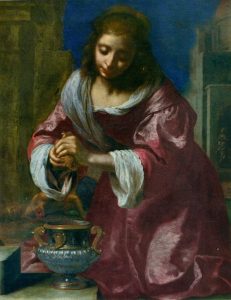
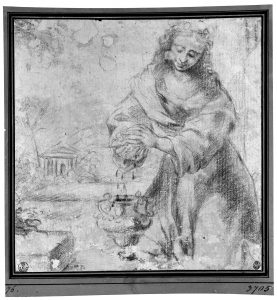
The painting at Dorotheum
A technical analysis and infrared photographs of the painting by Ficherelli offered for sale on 17 October 2017 have revealed several pentimenti (changes in the composition), demonstrating that the present work was modified during its execution. It was originally intended to have a much more ornate architectural structure on the right and a Tuscan column on the left, which in the finished painting is a simple square block. The beheaded martyr also appears to have been originally conceived slightly differently. The fact that both the Ferrara version and Vermeer’s copy follow the details of the finished present painting make it highly likely that this “Saint Praxedis” is the original version of the composition. A drawing conserved at the Uffizi also demonstrates that Ficherelli experimented with different compositional schemes for this work.
The central figure, wrapped in contemplation focusing on the vessel receiving the blood of the martyr, appears to have been conceived and consolidated at this early stage, whereas the architectural background and setting for the central scene were subject to several changes. In the drawing, Ficherelli placed the figure to the right of the composition, with a small Roman temple on the left in the background. When he began to paint and sketch on the present canvas, a column was originally incorporated and then painted over as if to recall the idea of the temple on the left. The same might be the case with the much more ornate structure to the right.
A plausible suggestion
Given these observations, it is plausible to suggest a chronology for the compositions due to the various stages of development: the first stage is represented by the drawing, with the figure of the Saint already designed, followed by the first painted version, the present “Saint Praxedis,” which went through several significant changes during its execution and thus represents the second and third states in the conception of the composition. Which of the other two versions was executed next – the copy attributed to Vermeer or the Ferrara variant – is impossible to determine based on the present painting.
The Ficherelli “Saint Praxedis” is offered in what is most probably its original 17th-century Florentine carved and gilded wooden frame.
Information: Mark MacDonnell, specialist for old master paintings
AUCTION
Old Master paintings
17 October 2017, 5 pm
Palais Dorotheum Vienna

